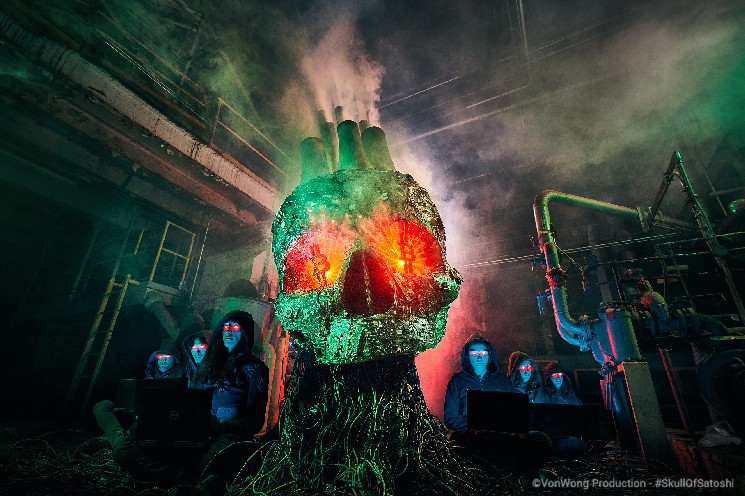The ‘Skull of Satoshi’ Proves Bitcoin Mining Discourse Isn’t Dead

Last week, Benjamin Von Wong unveiled an art installation he was commissioned to create by Greenpeace USA for its “Change the Code, Not the Climate” campaign. The $5 million campaign is funded by Ripple co-founder Chris Larsen and aims to change Bitcoin’s proof-of-work (PoW) consensus algorithm through a “code change” in order to save the environment.
The idea being that PoW uses energy and other consensus algorithms do not.
This article is excerpted from The Node, CoinDesk’s daily roundup of the most pivotal stories in blockchain and crypto news. You can subscribe to get the full newsletter here.
Von Wong’s art piece was revealed Thursday, March 23, in a blog post and video. He calls it the “Skull of Satoshi” – an apt name for an 11-foot tall skull made of wood, recycled styrofoam and 300+ pieces of electronic waste. The skull also features red laser eyes, a nod to the Bitcoin Twitter community who wear laser eyes in their profile pictures.
Instead of enraging the Bitcoin community, as Greenpeace’s campaign normally does, the Skull was almost immediately generally embraced because it was really cool.
I mean, just look at how metal, how punk rock the whole art installation is. It’s literally an 11-foot skull with glowing red laser eyes and smokestacks growing out the top. What’s not to love?
Bitcoiners tweeted about how much they liked the Skull of Satoshi and some changed their Twitter profile pictures. Still there was hesitation from others to embrace the art because of where the money behind it came from. From that angle, Von Wong was lambasted.
Without getting into too much detail, the conversation about moving Bitcoin from proof-of-work to something else, like proof-of-stake (PoS), which doesn’t use much energy, is generally a nonstarter. Bitcoin will almost certainly never move away from proof-of-work. That isn’t obvious from the outside, so that’s exactly where Von Wong began his journey to understand bitcoin mining.
In a reflective tweet thread, Von Wong said he thought the Bitcoin environmental problem was “black and white.” After the “phenomenal accident” of the Skull of Satoshi, Von Wong spent time in conversation with environmentalist bitcoiners including Level39, Troy Cross and Daniel Batten. He now recognizes that Bitcoin can be a powerful force for improving the environment.
This creates a somewhat interesting parallel. Greenpeace will still presumably use the Skull of Satoshi to promote its “change the code” campaign, but it will work everywhere except on the internet where the skull has become somewhat of a mascot for Bitcoin’s environmental potential even without moving its consensus mechanism from proof-of-work.
The story here is that Von Wong went from “there’s only one way to fix Bitcoin’s environmental problem” to “actually, there are many ways to fix Bitcoin’s environmental problem” in the space of a few days. It’s not a story because Von Wong is someone big, important or special. It’s a story because as more and more people get interested in Bitcoin the environmental question will certainly come up again and again. And bitcoiners will, and must, be ready to engage constructively.
For someone who has been around Bitcoin for a while, I viewed Von Wong’s learning process around the nuances of bitcoin mining as honestly unsurprising. The fact that it was carried out in what seemed like a relatively nonabrasive way bodes well for onboarding future environmentalist-leaning bitcoiners.
If Bitcoin is to succeed, we need more bitcoiners. And because Bitcoin and environmentalism are not mutually exclusive, there are ways for PoW blockchains to be a positive force.
Bitcoin is for everyone, including environmentalists.






 Bitcoin
Bitcoin  Ethereum
Ethereum  Tether
Tether  USDC
USDC  TRON
TRON  Dogecoin
Dogecoin  Cardano
Cardano  Bitcoin Cash
Bitcoin Cash  Chainlink
Chainlink  LEO Token
LEO Token  Stellar
Stellar  Monero
Monero  Zcash
Zcash  Litecoin
Litecoin  Hedera
Hedera  Dai
Dai  Cronos
Cronos  OKB
OKB  Tether Gold
Tether Gold  Ethereum Classic
Ethereum Classic  KuCoin
KuCoin  Gate
Gate  Algorand
Algorand  Cosmos Hub
Cosmos Hub  VeChain
VeChain  Dash
Dash  Stacks
Stacks  Tezos
Tezos  TrueUSD
TrueUSD  IOTA
IOTA  Basic Attention
Basic Attention  Decred
Decred  Theta Network
Theta Network  NEO
NEO  Synthetix
Synthetix  Qtum
Qtum  Ravencoin
Ravencoin  0x Protocol
0x Protocol  DigiByte
DigiByte  Zilliqa
Zilliqa  Nano
Nano  Siacoin
Siacoin  Numeraire
Numeraire  Waves
Waves  Enjin Coin
Enjin Coin  Ontology
Ontology  Status
Status  Pax Dollar
Pax Dollar  BUSD
BUSD  Hive
Hive  Lisk
Lisk  Steem
Steem  Huobi
Huobi  NEM
NEM  OMG Network
OMG Network  Augur
Augur  Bitcoin Gold
Bitcoin Gold  Ren
Ren